|
| Number of loops |
4
|
| transformation ratio |
i=4:3
|
| Number of cycles |
3
|
|
Remarks about the point, which creates the epitrochoid
- Remark about the shape of the epitochoid
|
|
The point (which created the epitrochoid) is on the edge of a ring
|
|
| approximate straight-line patterns |
0 |
| cusps |
0 |
| self-intersection points |
8 |
| self-tangential points |
0 |
number of alterations of
the center of curvature
|
0 |
|
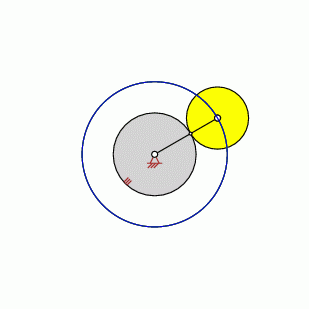
|
Point is identical with the center of the wheel
- The epitrochoid is a circle
|
|
The point (which created the epitrochoid) is on the ring-shaped surface
|
|
| approximate straight-line patterns |
0 |
| cusps |
0 |
| self-intersection points |
8 |
| self-tangential points |
0 |
number of alterations of
the center of curvature
|
0 |
|
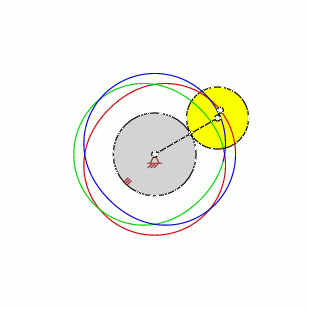
|
Point resides on the ring-shaped surface between the center of the wheel and the BALL Circle (BALL Curve)
- The center of curvature does not alternate to the other site of the curve.
|
|
The point (which created the epitrochoid) resides on the edge of a ring
|
|
| approximate straight-line patterns |
4
|
| cusps |
0 |
| self-intersection points |
8 |
| self-tangential points |
0 |
number of alterations of
the center of curvature
|
0 |
|
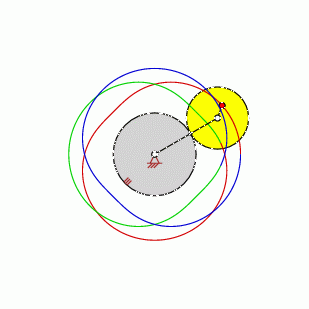
|
The point is a part of the BALL Circle (BALL Curve)
- The BALL Circle resides always between the pivot and the outer edge of the moving wheel
-
The radius of the BALL Circle is
1.285714285714286
for this transmission ratio
(multiplied by the radius of the moving wheel)
|
|
The point (which created the epitrochoid) is on the ring-shaped surface
|
|
| approximate straight-line patterns |
0 |
| cusps |
0 |
| self-intersection points |
8 |
| self-tangential points |
0 |
number of alterations of
the center of curvature
|
8
|
|
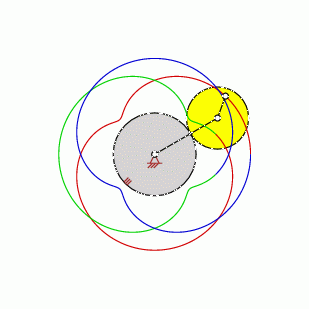
|
Point resides between the BALL Circle (BALL Curve) and the Moving Centrode
|
|
The point (which created the epitrochoid) is on the edge of a ring
|
|
| approximate straight-line patterns |
0 |
| cusps |
4
|
| self-intersection points |
8 |
| self-tangential points |
0 |
number of alterations of
the center of curvature
|
0 |
|
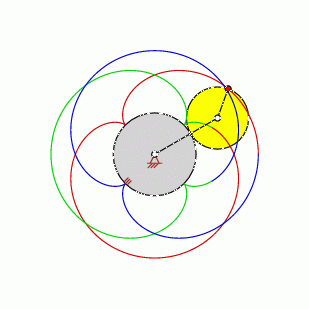
|
Point is part of the Moving Centrode
- The Moving Centrode is identical with the tread of the moving wheel.
-
The radius of the circular Moving Centrode is
3.0
(multiplied by the radius of the moving wheel)
|
|
The point (which created the epitrochoid) is on the ring-shaped surface
|
|
| approximate straight-line patterns |
0 |
| cusps |
0 |
| self-intersection points |
12
|
| self-tangential points |
0 |
number of alterations of
the center of curvature
|
0 |
|
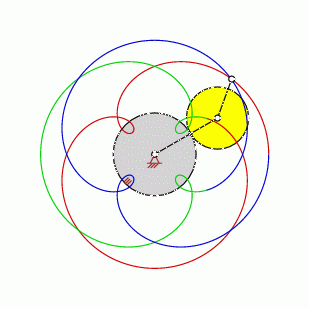
|
Point is outside of the Moving Centrode (outside of the tread of the wheel)
- Point resists between Moving Centrode and first Transition Curve.
|
|
The point (which created the epitrochoid) is on the edge of a ring
|
|
| approximate straight-line patterns |
0 |
| cusps |
0 |
| self-intersection points |
12
|
| self-tangential points |
4
|
number of alterations of
the center of curvature
|
0 |
|
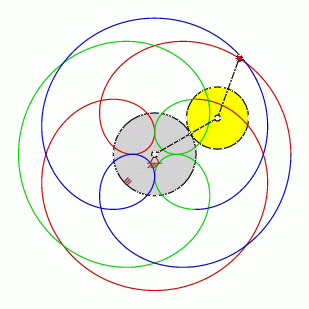
|
Point is part of the Transition Curve 1.
(of 2 Transition Curves)
- The circular Transition Curve resides outside the tread of the moving wheel
-
The radius of the Transition Curve is smaller or identical with the distance between the
pivot of the moving wheel
and the
pivot of the fixed wheel
-
The radius of the Transition Curve for this transmission ratio is
6.136
(multiplied by the radius of the moving wheel)
-
In this general case the near-by loops are in contact
(and not the opposite loops)
.
|
|
The point (which created the epitrochoid) is on the ring-shaped surface
|
|
| approximate straight-line patterns |
0 |
| cusps |
0 |
| self-intersection points |
20
|
| self-tangential points |
0 |
number of alterations of
the center of curvature
|
0 |
|
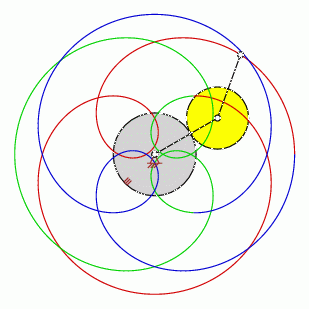
|
Point resids outside of the Transition Curve 1
(of 2 Transition Curves)
-
The variaton of the distance between the
point generating the epitrochoid
and the
pivot of the moving wheel
does not modify the qualitative characteristic of the shape of the epitrochoid as long a the point generating the epitrochoid
is positioned between Transition Curve1. and the Transition Curve
2.
|
|
The point (which created the epitrochoid) is on the edge of a ring
|
|
| approximate straight-line patterns |
0 |
| cusps |
0 |
| self-intersection points |
20
|
| self-tangential points |
2
|
number of alterations of
the center of curvature
|
0 |
|
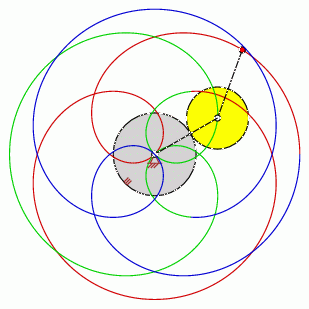
|
Point is part of the Transition Curve 2.
(of 2 Transition Curves)
- The circular Transition Curve resides outside the tread of the moving wheel
-
The radius of the Transition Curve is smaller or identical with the distance between the
pivot of the moving wheel
and the
pivot of the fixed wheel
-
The radius of the Transition Curve for this transmission ratio is
7.0
(multiplied by the radius of the moving wheel)
-
The radius of the Transition Curve is identical with the distance of both wheels:
In this special case only the opposite loops are in contact and not the near-by loops
|
|
The point (which created the epitrochoid) is on the ring-shaped surface
|
|
| approximate straight-line patterns |
0 |
| cusps |
0 |
| self-intersection points |
24
|
| self-tangential points |
0 |
number of alterations of
the center of curvature
|
0 |
|
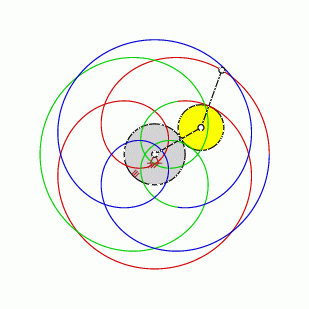
|
Point resids outside of the Transition Curve 2
(of 2 Transition Curves)
-
Any stretching of the distance between the
point generating the epitrochoid
and the
pivot of the moving wheel
do not change the qualitative characteristic of the shape of the epitrochoid as long as the point generating the epitrochoid
resides outside of the largest Transition Curve.
|


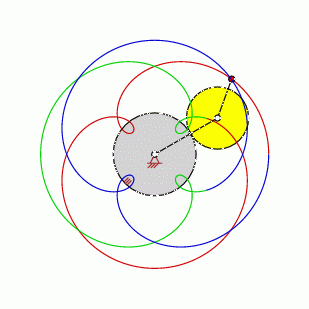 The overview of shape variation is based on
The overview of shape variation is based on





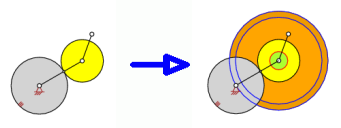 The circles are known, which borders the rings. They are called
The circles are known, which borders the rings. They are called